Conflict Zones
Where did India hit Pakistan? Mapping Operation Sindoor and border strikes | India-Pakistan Tensions News
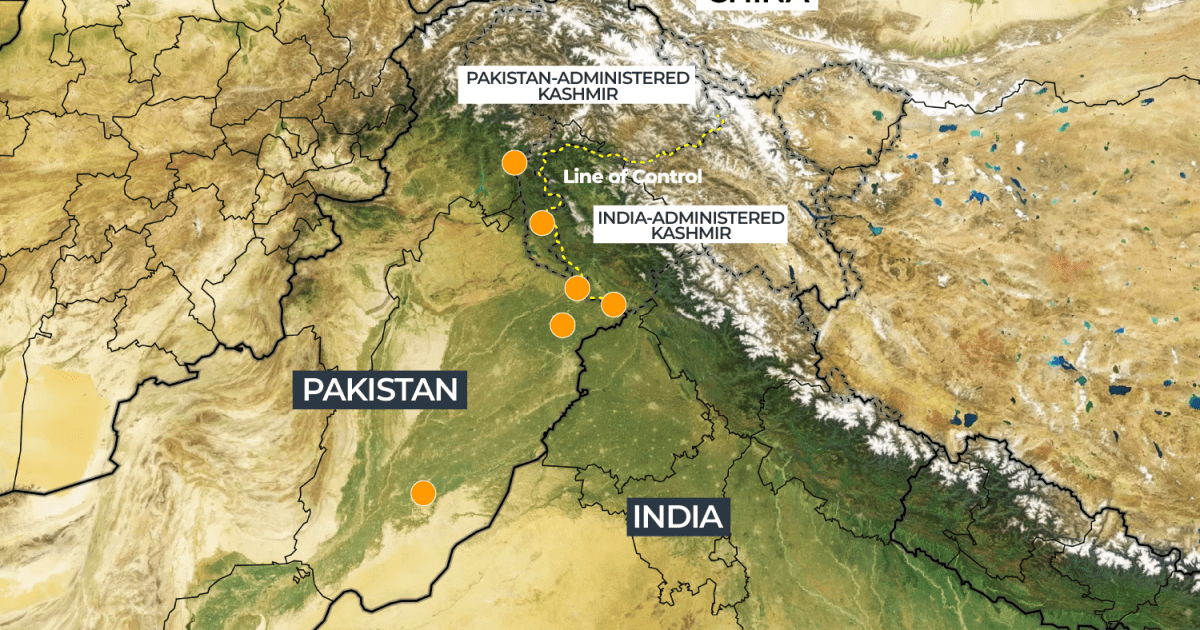
EXPLAINER
Pakistan says India’s missile attacks on six locations killed at least eight people and wounded more than 35.
Just after midnight on Wednesday, India’s army launched Operation Sindoor, hitting nine sites it described as “terrorist infrastructure” in Pakistan and Pakistan-administered Kashmir.
Pakistan’s armed forces said India’s military attacked six different places in Pakistan and Pakistan-administered Kashmir, launching 24 strikes, killing at least eight people and wounding more than 35.
The locations targeted in the attacks include:
Ahmedpur Sharqia, near Bahawalpur (Punjab province) – The deadliest strike occurred here, where a mosque compound was hit, killing at least five people, including a three-year-old girl, according to Lieutenant General Ahmed Sharif Chaudhry, spokesperson for the Pakistan Armed Forces.
Muridke city (Punjab province)
A village near Sialkot (Punjab province)
Shakargarh (Punjab province)
In Pakistan-administered Kashmir, two locations were also hit:
Muzaffarabad and Kotli – where two mosques were destroyed, killing a 16-year-old girl and an 18-year-old boy.

Pakistani officials claim their forces have also shot down five Indian warplanes. India did not immediately comment.
The Indian Army says Pakistani artillery fire killed at least three people in Indian-administered Kashmir.
Where is Kashmir?
Located in the northwest of the Indian subcontinent, Kashmir lies at a high altitude, with much of the region rising over 1,500 metres (4,900 feet) above sea level. It covers an area of 222,200 square kilometres (85,800 square miles).
The population is overwhelmingly Muslim, with approximately four million people living in Pakistan-administered Kashmir and about 13 million in Indian-administered Jammu and Kashmir.
The de facto border that divides Pakistan-administered Kashmir and Indian-administered Kashmir is known as the Line of Control (LoC). The line originally marked the military front when the two countries declared a ceasefire in January 1949 after their first war over Kashmir. It was formally named the LoC under the 1972 Simla Agreement, signed after the 1971 war that resulted in the creation of Bangladesh.

Who controls Kashmir?
India, Pakistan and China each claim parts of Kashmir.
Pakistan controls the northern and western portions, namely Gilgit and Baltistan and what Pakistan calls Azad Kashmir or “free Kashmir”. India controls the southern and southeastern parts, including the Kashmir Valley and its biggest city, Srinagar, as well as Jammu and Ladakh.
Pakistan calls Indian-administered Kashmir “Indian-occupied Kashmir”. India returns the favour – it calls Pakistan-administered Kashmir “Pakistan-occupied Kashmir”.

What happened during the Pahalgam attack?
On April 22, armed men opened fire on a group of tourists in Indian-administered Kashmir, killing 26 men in one of the deadliest attacks on tourists in decades.
The attack occurred in the Baisaran meadow, in Pahalgam, a well-known tourist destination located 50km (32 miles) southeast of the regional summer capital, Srinagar.
The Resistance Front (TRF), a little-known armed group, which India insists is a proxy for the Pakistan-based Lashkar-e-Taiba, claimed responsibility for the attack.

India has implied it believes Pakistan may have indirectly supported the Pahalgam attack – a claim Pakistan strongly denies.
Prior to Wednesday’s attacks, both countries had engaged in tit-for-tat diplomatic swipes at each other, including cancelling visas for each other’s citizens, recalling diplomatic staff and closing airspace to each other’s carriers.
Conflict Zones
‘Don’t want war’: Kashmiri towns caught in deadly India-Pakistan crossfire | India-Pakistan Tensions

Srinagar, Indian-administered Kashmir – As the camera panned around a home blown up by the mortar fire in Poonch, an embattled hill city perched on the disputed border between India and Pakistan, a disembodied female voice cried out.
“This is a calamity.”
The video, shared with Al Jazeera by locals in Poonch, revealed a collapsed staircase, large craters in the walls, and a courtyard cluttered with rubble and clothes, and painted in blood.
“Everything I built is in ruins,” the voice exclaimed, loaded with anguish.
At least 11 people have been killed in Poonch district from Pakistani firing into Indian-administered Kashmir since early May 7, in retaliation for Indian missile strikes that hit multiple sites across Pakistan’s Punjab province and Pakistan-administered Kashmir.
The Indian strikes – themselves a response to a deadly attack on tourists in Indian-administered Kashmir’s Pahalgam on April 22 – mark the most extensive attack on Pakistani soil since their 1971 war that ended with the eastern wing of Pakistan lopped off, resulting in the creation of Bangladesh.
Yet, as the nuclear-armed neighbours stand on the edge of a potential military conflict, many Kashmiris say they are facing the brunt of their tensions. Pakistan’s bombardment of Indian-administered Kashmir on Wednesday night was, according to locals and experts, the most intense shelling that villages and towns in the region have seen in more than 40 years.
“This was a night of terror,” Rameez Choudhary, a resident of Poonch, told Al Jazeera.
The dead, officials told Al Jazeera, included two siblings who were crushed to death after an exploding shell dropped on their house; two local store-owners who were hit by the raining munitions; a seven-year-old child; a teenage boy; a 35-year-old homemaker; and four other men.
The worst-hit villages in Poonch district were Shahpur, Mankote and Krishna Ghati, while shelling also intensified in Rajouri district’s Laam, Manjakote, and Gambhir Brahmana areas as residents fled to safety.

‘This war has been forced upon us’
The border skirmishes have followed the deadly attack at the tourist resort town of Pahalgam in Indian-administered Kashmir two weeks ago, in which 26 people, mostly Indian visitors holidaying in the disputed region, were killed.
During the wee hours on Wednesday, Indian military warplanes arced across the skyline and fired missiles and other munitions into neighbouring Pakistan. Indian authorities said they targeted at least nine locations inside Pakistan.
India charges Pakistan with supporting the armed group that attacked Indian tourists. Pakistan, however, has denied the accusation. India claims its missiles hit “terror base camps”, but Pakistan says the strikes killed 31 people, all of whom were “innocent civilians”.
The scale and spread of the current military tensions – India struck four cities separated by hundreds of kilometres in Pakistan’s Punjab province, in addition to sites in Pakistan-administered Kashmir – make them even graver, in some ways, than the last war between the neighbours in 1999, say some experts.
Back then, servicemen from the Pakistani army had disguised themselves as rebel fighters and taken up positions in the snow-covered, craggy mountains of Kargil, territory under de facto Indian control, leading to a conflict. Hundreds of soldiers died on each side, but the battles were – unlike this week – contained to Kargil.
“This war has been forced upon us. The [Pahalgam] attack was aimed at provoking a situation in which we have no option but to strike back,” said Tara Kartha, director at the Centre for Land Warfare Studies (CLAWS), a New Delhi-based think tank, and a former official at India’s National Security Council Secretariat.
To be sure, the countries came close to war in 2019 in the aftermath of the deadly attack in Pulwama town in South Kashmir when a suicide bomber blew up an Indian paramilitary motorcade, killing 40 Indian servicemen. Indian fighter jets fired missiles that struck Balakot in Pakistan-administered Kashmir.
But according to Kartha, the current crisis is different.
“Both sides carefully managed 2019. Everything was kept confined to a certain limit. But this time, it has been brutal,” she said, while arguing that “India has been very mature”. Pakistan’s military and civilian government have, however, accused India of fanning the flames of war and escalating tensions.
Caught on the front lines of their confrontation are Kashmiris. On Wednesday, three different regions in Indian-administered Kashmir were struck by Pakistani shelling.
“Initially, we thought it was thunder. The skies rumbled at 1am,” Altaf Amin, a 22-year-old resident of Chandak village in Poonch, told Al Jazeera.

‘We don’t want war’
Poonch is just 10km (six miles) from the Line of Control (LoC), the contested border that separates the Indian- and Pakistan-controlled territories in Kashmir. “The shelling has continued on and off since yesterday. But now, it has stopped,” said Amin.
Social media was quickly flooded with videos showing the severity of the human toll in the border shelling. A clip whose veracity was authenticated by Al Jazeera shows the bloodied body of a teenage boy being carried into a van in Poonch. One of his arms had been blown apart. The different segments in the same clip showed a lifeless body of a child, his head ripped open by a shell.
Amid it all, one refrain emerged loud and clear: “We don’t want war,” said Amin.
Yet, there is also anger on the ground against local authorities.
“People in Poonch are angry because there was no attempt to get them evacuated,” Zafar Choudhary, a political analyst and veteran journalist based in the Jammu region, told Al Jazeera.
Choudhary said that the strikes from the Pakistani side should have been anticipated by the Indian government, and people should have been evacuated to avoid the casualties.
“But none of that happened, which has left people infuriated. There’s a feeling that whenever the trouble between the two warring nations has erupted in the past, it is the people of these hill regions who have borne its brunt,” he said.

Silent guns roar again
The LoC traverses a 740km (459-mile) circuitous route through the mountains, forested ridges, alpine lakes and rivers of the disputed Kashmir region. The line came into being in 1949 after the newly independent India and Pakistan fought their first war over Kashmir, which was then one of the 565 princely states ruled indirectly by colonial Britain.
As both countries rallied their militaries to claim the picturesque region, they eventually settled for a stalemate that forced them to recognise each other’s spheres of influence. The ceasefire line was given recognition by the United Nations, which tried to mediate a referendum in Kashmir so that its people could choose their future.
The vote never happened, and both nations continued to spar occasionally along the disputed border. After the 1971 war that Pakistan lost to India, the ceasefire line was renamed as the LoC. In 2003, after a more than decade-long uprising in Kashmir began to subside, and both countries initiated a peace process to ease hostilities, India took advantage of the truce period to fence off its side of LoC with spools of concertina wire.
The two countries agreed to a ceasefire deal that they renewed in 2021.
Four years later, that agreement effectively lies in tatters.

‘This shelling is unprecedented’
Amin, the villager in Chandak, said that although artillery duels have been common in the border area, the guns had fallen relatively silent since both countries reaffirmed the 2003 ceasefire deal four years ago. “We are familiar with cross-border shelling. But this shelling is unprecedented.”
Another resident from Poonch, which is where most damage has taken place, said that people there have now started following a series of war protocols announced by the government, including building makeshift bunkers.
Residents said many schools in Chandak have been converted into relief centres, with provisions of food and other essentials.
Nearly 260km (162 miles) away from Poonch district, the residents of Salamabad Uri, a border village in Baramulla district, northern Kashmir, have fled their homes, too.
“Last night, the shelling was so intense that two houses were burned down and many people were wounded in the fire from across the border,” Mushtaq Ahmad, 40, a cab driver from the village, said. Ahmad has now moved to the town of Uri.
Salamabad, which is ringed by a pine-covered massif that juts out into Pakistan, has been devastated by near-continuous shelling. Powerful blasts have ripped away corrugated iron roofs from homes, exposing them to harsh sunlight. The inferno caused by the shelling has blazed through neighbourhoods, leaving behind smouldering debris.
“We fear the worst,” said Ahmad, adding that his two daughters, aged 9 and 11, are frightened.
“They are asking why it happened? Would we be killed?” Ahmad says, adding that the cross-border shelling started at 2am on Wednesday, and left two minors – a 13-year-old girl and a four-year-old boy – wounded.
Ghulam Muhammad Chopan, an 80-year-old resident, said that he felt too old to leave his home, but that there was no other option.
“At this age, I had to leave my house. At night, the firing was so intense that by dawn, the village was empty. Everyone fled,” he said.
In Wuyan town in Pampore, a highland area surrounded by a maze of escarpments where the prized Kashmiri saffron grows, townspeople said they were jolted out of their sleep at 1:30am after they heard a loud booming sound.
“A fireball exploded with a flash,” said Gulzar Ahmad, a resident. “I could see two aircraft. One of them returned promptly. But the other one that exploded, its wreckage had fallen into a school playground. Later, it started emitting acrid smoke that drew a large crowd.”
Pakistan claims it shot down five Indian fighter jets on Wednesday morning. While multiple independent reports suggest that at least three planes were indeed shot down, India is yet to confirm any such losses.
As uncertainty lingers over the escalation of tensions between India and Pakistan, locals in Indian-administered Kashmir are fearful and uncertain about their future.
Residents have started hoarding food, fuel and other essential items, anxious and desperate to survive violence they never invited.
“War should never be rejoiced. When the shells hit, they don’t ask your identity,” said Farooq Ahmad, a resident of Kamalkote village in Uri. “Those calling for the war do not know how it feels when a shell lands on your kids when they are asleep at night.”
Conflict Zones
Information war: Are India or Pakistan telling the truth about attacks? | India-Pakistan Tensions News

Competing press briefings. Divergent claims. And conflicting narratives.
As Indian attacks on Pakistan and Pakistan-administered Kashmir early in the morning on May 7 pulled the nuclear-armed neighbours to the brink of a potential military conflict, a parallel war quickly broke out — over information.
Within hours of the Indian strikes, authorities on both sides put out claims and counterclaims that have been amplified on social media as each country tries to control the narrative in its favour.
Five Indian jets were downed, Pakistan said, for instance. India has yet to respond to the claim: Officials who requested anonymity confirmed that three jets had crashed in Indian-administered Kashmir, but did not confirm whether they were Indian or Pakistani planes.
Here is a look at what both India and Pakistan have claimed so far — and how they have a history of competing narratives that often allow them to each assert wins over the other to their respective domestic audiences, while making independent verification of the truth harder.
What was targeted?
India said its forces hit “terrorist infrastructure” at nine sites in response to last month’s deadly shooting attack in Pahalgam in India-administered Kashmir. India blamed Pakistan for the Pahalgam attack, in which 26 civilians were killed. Islamabad denied the charges and asked India to provide evidence to back up its claims.
Pakistan said Indian forces on Wednesday hit six cities in Pakistan and Pakistan-administered Kashmir and a health centre.
Pakistan said civilians were killed, including a three-year-old girl.
But Indian Defence Minister Rajnath Singh said his forces did not harm civilians. In a news briefing, Indian air force Wing Commander Vyomika Singh said the strikes led to “no collateral damage” and had been conducted through “precision capability”.

Did Indian forces hoist a white flag at LoC?
The Pakistani government on its official X account said Indian soldiers raised a white flag, a common symbol of surrender, at a military post along the Line of Control, the de facto border that divides Indian-administered and Pakistan-administered Kashmir.
Pakistani Minister for Information and Broadcasting Attaullah Tarar echoed the claim on his X account, posting: “First they fled from the investigation, now they fled from the field.”
Indian authorities have yet to formally address the claim, but as India and Pakistan are not officially at war, it is unclear why New Delhi might feel the need to surrender.
Were warplanes downed? How many? And who did they belong to?
Pakistan military spokesperson Ahmed Sharif Chaudhry said five Indian jets had been downed, all within Indian territory, with planes from neither side crossing into the other’s airspace.
According to Indian security sources who spoke to Al Jazeera, three fighter jets have been downed inside Indian-controlled territory. However, it was not clear whether they were Pakistani or Indian warplanes.
While there has been no comment from the federal government, the Indian embassy in China dismissed claims of Indian jets being brought down in Chinese state media outlet Global Times as “disinformation”.

History of conflicting claims
Previous escalations between India and Pakistan have also generated conflicting claims and accusations, often leaving observers to ponder which account — if either — reflects the truth.
In February 2019, Indian forces said they had hit a large number of “JeM [Jaish-e-Muhammad] terrorists, trainers, senior commanders and groups of jihadis” in Balakot in Pakistan-administered Kashmir, weeks after a suicide attack killed 40 members of the security forces in India-administered Kashmir’s Pulwama.
Formed in 2000, JeM has carried out numerous attacks on Indian forces in India-administered Kashmir. Both India and Pakistan have designated the armed group as a “terrorist organisation”, but its leader Masood Azhar has been allowed to operate in Pakistan. His current whereabouts are unknown.
Pakistan, which denied having a role in the Pulwama attack, said the Indian air attacks in 2019 hit an uninhabited forest.
Similarly, in 2016, Pakistan rejected India’s claims of “surgical strikes” against “terrorist units” on its territory after an attack on an Indian army base that killed 18 soldiers in Uri in India-administered Kashmir.
The Pakistani military called the claims an “illusion” and said India had engaged in nothing more than “cross-border fire, … which is an existential phenomenon”.
Conflict Zones
Operation Sindoor: What’s the significance of India’s Pakistan targets? | India-Pakistan Tensions News

The Indian military launched multiple missile attacks targeting sites in Pakistan and Pakistan-administered Kashmir early on Wednesday in an attack it called Operation Sindoor. The Pakistani military claims to have retaliated, shooting down multiple Indian military planes.
At least 26 Pakistanis have been killed in the six targeted cities, according to Lieutenant Ahmed Sharif Chaudhry, the director general of the Inter-Services Public Relations (ISPR) media wing of Pakistan’s military. India says it struck nine sites.
But what’s the significance of the cities and sites that India attacked? And what are India and Pakistan saying about those strikes? And why did India launch these attacks in the first place?
Why did India strike Pakistan?
The missiles were India’s response to the deadly April 22 attack on tourists in Indian-administered Kashmir in Pahalgam, during which 26 men were killed.
An armed group called The Resistance Front (TRF), which demands independence for Kashmir, claimed responsibility for the Pahalgam attack. India claims that the TRF is an offshoot of Pakistan-based armed group, the Lashkar-e-Taiba (LeT). Islamabad has denied its involvement in the Pahalgam attack and has asked for a neutral investigation into the incident.
However, since the attack, India has suspended its participation in the Indus Waters Treaty that Pakistan relies on for its water supply. Pakistan has responded by threatening to suspend its participation in the Simla Agreement, a pact signed in 1972 following the Indo-Pakistan War. Both countries have also scaled back their diplomatic ties, and each has expelled the other’s citizens.
How has India justified the attacks?
India claims it hit “terrorist infrastructure”, targeting organisations including the LeT and Jaish-e-Muhammad (JeM), an armed group based in Pakistan which claimed responsibility for a suicide bombing in February 2019, which killed 40 Indian paramilitary soldiers in Pulwama in Indian-administered Kashmir.
In a briefing on Wednesday, Indian Foreign Secretary Vikram Misri insisted that the missile strikes “focused on dismantling the terrorist infrastructure and disabling terrorists likely to be sent across to India”.
Joining Misri in the briefing, Indian military officials Colonel Sofiya Qureshi and Wing Commander Vyomika Singh detailed the operation. Five of the nine sites that India hit, they said, were in Pakistan-administered Kashmir. The remaining four were in Punjab – in Bahawalpur, Muridke, Shakar Garh and a village near Sialkot.
During the briefing, the Indian military showed a map marking out what it claimed were 21 “terrorist camps” in Pakistan and Pakistan-administered Kashmir. Al Jazeera has not been able to independently verify the claims of either the Indian or Pakistani militaries.

What has Pakistan said about the sites attacked?
Chaudhry of the ISPR described the Indian strikes as an “unprovoked attack, targeting innocent people”. He indicated that India had launched a total of 24 strikes across six locations in Pakistan and Pakistan-administered Kashmir.
Chaudhry said at least 26 civilians, including women and children, had been killed, and at least 46 people were injured. He claimed mosques and residential areas were targeted, killing and injuring civilians.

What’s the significance of the sites targeted by India?
The Indian missile strikes represent the most extensive attacks on Pakistani soil outside the four wars that the nuclear-armed neighbours have fought. They also mark the first time since the war of 1971 that India has attacked Punjab, Pakistan’s most populated province and historical and economic hub.
Unlike previous aerial attacks by India in Pakistan or in Pakistan-administered Kashmir, some of these strikes targeted large population centres. Muridke is next to Lahore, Pakistan’s second-most populous city. Sialkot and Bahawalpur are major cities, too.
But many of the sites chosen as targets by India also hold specific strategic importance, at least from New Delhi’s perspective. Here’s a breakdown:
Muridke, Punjab
Muridke is a city in Punjab’s Sheikhupura District, peppered with totems of historical memory from the Mughal, Mauryan and Gupta eras.
Chaudhry said a mosque named Masjid Ummul Qura was targeted with four strikes. One man was killed and one man was injured as a result. Two people have been missing from this location, Chaudhry said, adding that surrounding residential quarters have also been damaged in these attacks.
But the town, according to India and much of the international community, also hosts the headquarters of the Jamat-ud-Dawa, a charity organisation that New Delhi insists is a front for the LeT.
On Wednesday, India’s Qureshi claimed that Indian missiles struck the LeT’s Markaz Taiba camp in Muridke. The Indian army claimed that key perpetrators of the 2008 Mumbai attack – including Ajmal Kasab, the sole gunman who was captured alive after that assault on India’s financial capital – were trained at that camp.
Meanwhile, images emerging from Muridke showed rescuers searching for victims amid the debris of a damaged government health and education complex.
Bahawalpur, Punjab
Chaudhry said that four Indian missiles struck Ahmedpur Sharqia, a town near Bahawalpur, targeting a mosque named Masjid Subhan, which was destroyed in the attack. He said that at least five people were killed in the attack, including two men, two women, and a three-year-old girl. Additionally, he said, 31 people were injured – 25 men and six women. He added that four “residential quarters”, where civilian families were living, were damaged.
But Qureshi said India had hit the headquarters of the JeM, called Markaz Subhanallah. India described the site as a hub for “recruitment, training and indoctrination”.
Muzaffarabad, Pakistan-administered Kashmir
Muzaffarabad is the capital city of Pakistan-administered Kashmir, located at the confluence of the Jhelum and Neelum rivers. Muzaffarabad is sustained by its cottage industry ecosystem, including furniture making, wood carving, garment making and embroidery work, according to the State Bank of Pakistan.
Chaudhry said that a mosque called Masjid e Bilal was hit in Muzaffarabad, and a “young girl was injured”.
But Qureshi said India hit a LeT training centre, Sawai Nala camp in Muzaffarabad, 30km (19 miles) away from the Line of Control (LoC), the de facto border that separates Indian-administered and Pakistan-administered Kashmir. She claimed that those responsible for multiple attacks, including the April 22 Pahalgam killings, were trained at this camp.
The Indian military officials also said they attacked a Jaish-e-Muhammad “staging area”, the Syedna Bilal camp in Muzaffarabad. A staging area refers to a place where people, vehicles and equipment are assembled and readied before being assigned a mission.
Kotli, Pakistan-administered Kashmir
Kotli is a city along the Poonch river and is an agricultural and tourist hub.
Chaudhry said a mosque named Masjid Abbas was targeted in Kotli. A 16-year-old girl and an 18-year-old boy were killed. At least two other people were injured, he added.
Qureshi, however, said that India hit a LeT base, Gulpur camp, about 30km (19 miles) away from the LoC. The Indian army added that it also struck what it called the Abbas camp in Kotli, 13km (8 miles) away from the LoC, where Qureshi said up to 15 “terrorists” could be trained at a time.
Qureshi said India has also hit Mehmoona Joya, which she described as a facility of the Hizbul Mujahideen (HuM), a rebel group based in Indian-administered Kashmir. The HuM was founded by separatist leader Muhammad Ahsan Dar in September 1989, with a pro-Pakistan ideology, calling for India to leave the parts of Kashmir that it administers.
Bhimber, Pakistan-administered Kashmir
Qureshi claimed India struck what India called the Barnala camp in Bhimber, about 9km (5.6 miles) away from the LoC. She claimed that fighters were trained in using weapons, improvised explosive devices (IEDs) and in jungle survival at this camp.
Pakistani officials had not mentioned Bhimber as the site of any of the Indian attacks by late Wednesday evening. However, Bhimber is just south of Kotli, so it is unclear whether a missile strike on Bhimber is being counted by Pakistan as among the attacks on Kotli.
Sialkot, Punjab
Sialkot is one of Pakistan’s most important industrial centres for the manufacture of surgical items, sporting goods and leather products.
Chaudhry said that a village north of Sialkot called Kotli Loharan was targeted in two strikes. One of these strikes misfired and did not explode, while the other landed in an open field, resulting in no damage, Chaudhry said.
India’s Qureshi and Singh, however, claimed that India had struck what they called the Sarjal camp in Sialkot. They claimed this was the training centre for those responsible for the killing of four police officers in March this year in Indian-administered Kashmir.
Shakar Garh, Punjab
Chaudhry said Shakar Garh was targeted with two strikes and reported “minor damage” to a “small hospital, a dispensary”.
However, Indian military officials have not mentioned Shakar Garh among the places targeted in the May 7 strikes.
-
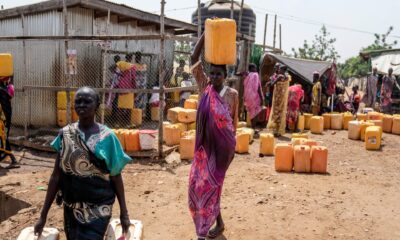
 Conflict Zones2 days ago
Conflict Zones2 days ago‘We are suffering’: Displaced families bear burden of South Sudan conflict | Humanitarian Crises News
-

 Sports2 days ago
Sports2 days agoLindsey Vonn says she proved to herself and her doubters that ‘I deserve to be here’ after skiing return
-
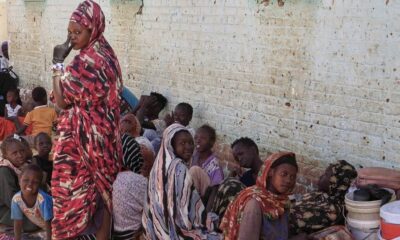
 Africa2 days ago
Africa2 days agoNew wave of Sudanese refugees flee into neighbouring Chad
-
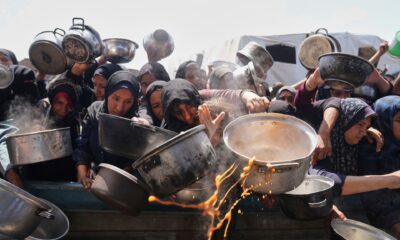
 Middle East2 days ago
Middle East2 days agoNo sense in Gaza ceasefire talks amid Israel’s ‘hunger war’: Hamas | Israel-Palestine conflict News
-

 Middle East2 days ago
Middle East2 days agoIsrael has turned 70% of Gaza into no-go zones, in maps | Israel-Palestine conflict News
-

 Lifestyle2 days ago
Lifestyle2 days agoOne Tech Tip: Skype shut down for good, but users still have these alternatives
-
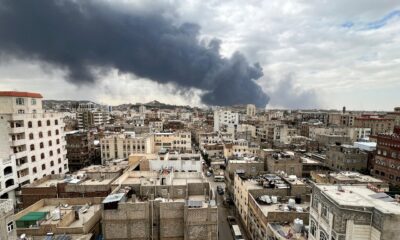
 Middle East2 days ago
Middle East2 days agoIsrael hits Yemen’s Houthi-controlled Sanaa airport in tit-for-tat attack | Houthis News
-

 Europe2 days ago
Europe2 days agoTesla sales plunge across Europe




